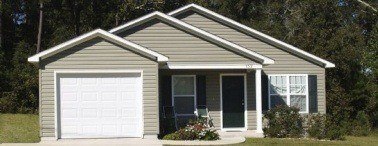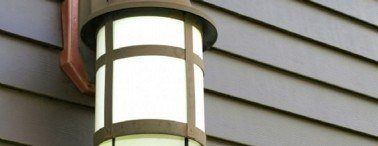
Siding can do a great deal for the appearance of your home. Not only can it increase the resale value, but it can literally give your house a facelift, drastically changing or subtly enhancing its appearance. With so many different siding options available today, it's easy to feel intimidated. There's no need to worry, however. With a few simple tips on how to avoid the most common mistakes, you can add visual appeal and value to your home without headaches.
Here, we'll cover some of the most common mistakes homeowners make when choosing and installing siding. These include both DIY projects and professional installations. While you can't control every move that a hired pro makes while working on your home, you can take steps to avoid common hassles.
Siding Mistake #1 - Sabotaging Your Siding with Landscaping
A very popular landscaping choice is to plant decorative bushes or shrubs close to the house. While this can look very nice, it can also wreak havoc on your siding, and ultimately your home's structure, if certain precautions are not taken.
Dense shrubbery tends to trap moisture. While all outdoor siding is designed to be resistant to the elements, it's not designed to sit in a damp environment all day long. Excess moisture, if it's present regularly for a long period of time, can cause severe damage to the siding itself and, eventually, to the structure of your home. Water trapped in this area can eventually work its way underneath siding, exposing the underlying materials. In most cases, these materials have not been designed to withstand very much moisture, and they will quickly begin to break down. In time, this can lead to sagging walls which may need to be torn out and replaced, resulting in a major inconvenience and astronomical costs.
Play it safe when landscaping, and resist the urge to plant anything dense right next to your home. Opt instead for low-growing shrubs or ornamental flowering plants. Planting extremely close to the home is fine, as long as no large roots will eventually invade pipes or basements, and as long as no dense leaves are in constant contact with siding.
Siding Mistake #2 - Choosing Inferior Products
For many years, vinyl and aluminum siding have been considered standard on most mid-range homes. There are definite advantages to these products; they're relatively durable, most varieties don't require much maintenance, and they're inexpensive.
However, most experts will agree that aluminum and vinyl are simply not the best choices available. While they have advantages, their disadvantages are many. Aluminum siding dents easily and often shows paint chips soon after installation. Vinyl siding often cracks, splits and chips in areas which experience extreme cold, and in any climate after a few years. If your budget will only allow for aluminum or vinyl siding, choose vinyl, and choose one of the better brands. These brands come with guarantees. Look for one which extends at least five years.
Siding Mistake #3 - Sloppy Installation
Although this error is more commonly seen in DIY projects, inexperienced professionals are not immune. Sloppily installed siding not only looks horrible, but it leaves gaps in the siding which allow moisture to enter and damage your home.
The most common areas for visibly crooked or improperly installed siding are around windows, doors and any other obstacle such as air conditioners. Cutting and fitting siding panels can be tricky, and measuring precisely is a must. Unfortunately, in the rush to get the job done, homeowners and professionals alike often slip up.
Another way for sloppy installation to show itself is in a crooked panel. Many forms of siding interlock, meaning that each panel must be pressed tightly against the panel above it before being nailed into place. A very slight degree of variation may not seem like a big deal up close, but when viewed from the street or yard, that crooked panel will stick out and catch your eye.
In order to avoid these common mistakes, simply take your time. If you're installing siding yourself, go slowly and be sure to measure accurately. If you've hired professionals, be careful not to seem impatient; this is likely to make them rush, which contributes to mistakes. In addition, don't be afraid to point out a crooked panel or a sloppy corner cut if you spot one. Mentioning these things right away is much better, since you won't have to wait for a worker to come back and put things right.
Siding Mistake #4 - Inexperienced DIY Work
In today's uncertain economy, it's only natural to want to save money. Often, homeowners try to do this by performing their own home improvement projects. While many projects can be done on a DIY basis with beautiful results, siding is something that requires careful consideration.
If you've never installed siding before, watch the job being done to get a better idea of just how much work is involved. One aspect to consider is the length of the siding panels. This may seem trivial, but in reality it results in many crooked installations. Having two or more people working on a siding project produces the best results, simply because it's easier. If you can't recruit a couple of willing friends, family members or neighbors, you may be better off hiring a pro.
Another consideration when installing siding is the potential for dangerous falls. Falling even a few feet off a ladder, if you land in an awkward manner, can cause serious injury. This risk becomes even greater if you're not used to working while balancing on a ladder, which the average homeowner is not.
Ultimately, all it takes to avoid biting off more than you can chew is an honest evaluation of your skills and available time. If you can't get the job done right, why waste the money and effort? Do a bit of research, hire a reputable work crew, and get it done right the first time.
Siding Mistake #5 - Clashing Your Colors, Patterns and Materials
Creating a harmonious appearance can easily be achieved with siding. Unfortunately, it's just as easy to end up with clashing results if the wrong mix of color, pattern and material is used.
With so many siding options available today, it's very easy for homeowners to create a beautifully customized exterior. One very popular option involves finishing the lower story of a home in faux brick siding while using traditional siding on the upper story. Another daring trend that's growing in popularity is to use two or more colors of siding on the same house, creating dramatic visual appeal while showing off your personal style.
While both of these design options can result in stunningly beautiful exteriors, they can just as easily wind up creating glaring eyesores which detract from your home's appearance and value.
While it's very easy to combine colors, it's generally quite difficult to correctly envision how they will look on a very large scale once they're in place. To avoid these truly unsightly mistakes, utilize the computer programs available online and at many home supply stores. These fun and simple programs allow you to view a home with your chosen colors, patterns and materials, giving you a much more accurate picture of how your home will eventually look. Not only does this save you the time and expense of redoing an ugly combination, but it gives you the flexibility to test out some interesting combinations you might never have thought up on your own.
Siding Mistake #6 - Stifling Your Personal Style
Now that we've covered the dangers of going too far when combining colors and patterns, it's important to mention the flip side of this issue. Far too many homeowners make the unfortunate mistake of choosing siding in a color and pattern which is nearly identical to the siding on their neighbors' homes. While there's nothing truly wrong with this decision, it does take some of the fun out of owning your own home.
If you really love a color or pattern which just happens to be similar to your neighbor's, go ahead and use it. However, unless regulations are in place which require the use of certain neutral shades (common in some subdivisions), use this opportunity to let your creative side shine.
This doesn't necessarily mean going crazy and siding your home in bright pink. It simply means not being afraid to take a few calculated risks. Some very dramatic colors, such as greens, reds and deep blues, can look stunning when used in siding a home. They can also be combined with more neutral shades to create a contrast.
Using the computer programs we mentioned above, play around with a few combinations you think might look good. If you're wrong, you've lost nothing. If you're right and you find an unconventional combination that looks great, you'll end up with the most eye-catching house in the neighborhood!
Think Things Through
As you can see, the most common siding mistakes can be easily avoided. Simply think each decision through, carefully and logically, before you commit. Choosing vinyl over wood will save you money right now, but you may be facing a redo in just a few years when you can afford a more durable and attractive option. DIY work is great, but beware of the dangers. Think through (and accurately visualize) those color combinations before they're actually on your home.
All these steps are simple matters of slowing down and approaching your siding project with a careful eye for detail.
Posted by: Diane Sheppard





